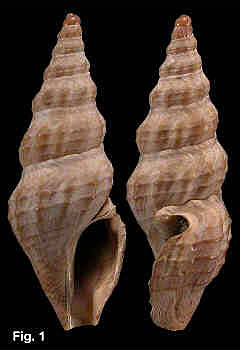|
|
|
|
Vexitomina suavis (Smith, 1888) Description: Protoconch of two smooth whorls. Teleoconch six whorls, aperture one-third of total shell length. Spire whorls concave at upper third, crossed by fine curved growth lines; periphery of whorls with elongate, oblique nodules that extend to bottom of whorls, about 10 on penultimate whorl; spiral sculpture of two or three widely and evenly spaced primary threads which thicken where they cross the axial nodules, with 2-5 secondary threads between primaries. Body whorl with 4 or 5 primary threads on upper half, and similar but weaker and more closely spaced primaries on base, all with intervening secondary threads. Last axial fold on body whorl, immediately before outer lip, is enlarged. Columella smooth. Sinus U shaped; approximately hemispherical nodule above sinus, under overhanging extension of outer lip. Colour fawn or brown, interior brown in some specimens. Size: Up to 17 mm in length. Distribution: Endemic to Australia; known from Port Stephens to Twofold Bay, NSW. Habitat: Subtidal, 9-155 m. Rare Comparison: Identified by the regular primary spiral ribs, the nodule under the outer lip extension above the sinus, and the enlarged axial fold on the body whorl before the outer lip. Specimens of Vexitomina torquata have a similar nodule, and can occasionally have regular spiral ribs but do not show the last fold thickening. Remarks: This species was described in 1888 from a single specimen from off Cape Three Points, (north of Broken Bay). A second example (C.16464) was collected in the same locality in 1898 (Fig. 1). The species was known only from these two shells until 2004, when 10 more lots were identified from unsorted material in the Australian Museum collection by the author. Fig. 1: Off Cape Three Points, NSW (C.016464) |
